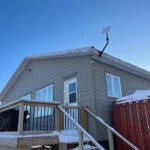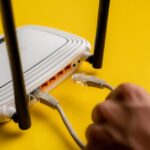Table of Contents
Fibre internet offers consistent, reliable and the fastest internet connection to residential and commercial users, eliminating the issues of buffering and outages.
In this article, you will learn about the working mechanism of fibre internet, its advantages, essential requirements, and the installation process. You can also get information about full fibre and partial fibre connection and the factors affecting the internet speed.
How Does Fibre Internet Work?
Fibre optics uses light to transmit data over long distances. The speed of light, i.e. 300,000 km/s, allows it to transfer the data at an unprecedented speed. This is the main reason behind fibre internet being the fastest internet ever.
The transmission process involves a light emitting diode installed at one end of the cable that converts the information into light energy. This beam of light is transmitted into the OFC at an angle greater than the critical angle of the fibre optic glass which results into the consistent bouncing of the beam unless it reaches the receiver’s end. The receiver’s end is equipped with the instrument to convert the light into information and the send it to the user.
Advantages of Fibre Internet
The following are some of the advantages of installing fibre internet:
- Faster Speed
- Fewer Long Outages
- Smoother Video Calls
- Fewer Connection Dropouts
- Faster Downloads and Uploads
- Allows Connection of More Devices
- Higher Quality Audio and Video Streaming
Essential Requirements for Installing Fibre Wireless Internet
You or anyone over 18 years old should be in the property when experts come for Wifi setup. There should be two spare plug sockets at the location, which will be the entry point of fibre. The two sockets are required for powering the broadband router and the new connection box. You must also get your landlord’s permission before internet installation if you live in a rented property.
Process of Installing Fibre Internet
You need to hire the services of professional technicians for fibre internet installation at your property who have all the experience to complete this work efficiently.
The installation process of fibre internet is completed by the specialists in the following steps:
- Conducting a fibre cabling survey of your property for collecting all the needed information.
- Analysing the location of devices which require fast speeds, such as gaming consoles, smart TVs, etc.
- Checking cable containment, cable ductwork, network cabling racks, overhead cabling, and patch panels.
- Specifying cable type and mode after planning and agreeing upon cable route.
- Analysing the required fibre cable’s distance for carrying the signals.
- Visiting your street before the installation day to confirm there are no blockage issues.
- Suggesting the best location for installation of your new router to provide you with the best coverage and internet speed.
- Starting the installation of fibre-optic network by running a fibre cable outside your premises.
- Connecting fibre cable from the street to your property by installing two new boxes, one outside and the other inside your property.
- Drilling a small hole near a plug socket through an external wall for connecting the modem.
- Installing the router for your new wireless network.
- Performing quick tests after complete Wifi setup to ensure everything works correctly.
Full Fibre VS Partial Fibre Connection
Full fibre, also called FTTP (Fibre to the Premises), involves the direct connection of fibre cables to your property. There is no slowing down of the internet signals between the street cabinet and your property, offering a fast internet speed.
On the other hand, only a part of partial fibre connection involves using fibre optic cables. The fibre cables are connected to the street’s cabinet, while the rest of the connection is made by using your landline’s copper phone line. It results in a decrease in the internet speed.
Factors Affecting the Internet Speed
The following are some of the factors which affect the internet connection speed:
- Time of Day
- Hardware Quality
- Weather Conditions
- Viruses and Malware
- Number of Connected Devices
- Number of Electrical Devices in Your Property
Contact Us
Get in touch with our company to get certified and licenced internet solutions and avail of our 24/7 services for fibre internet installation.
FAQs
What is the difference between single-mode and multimode fibre cables?
One of the significant differences between single-mode and multimode fibre cables is fibre transmission distance. A single-mode fibre cable transmits signals over short and long distances; however, a multimode fibre cable can transmit signals from 300m to 550m.
How much time is required to install fibre internet?
You can opt for Wi-Fi installation no matter the sector and type of your business, including construction, hospitality, warehouse, leisure facilities, hotels, or any other business.
What is the speed of fibre internet?
The fibre internet speed ranges from 30Mbps to 512Mbps. However, this speed can be as much as 1Gbps with a full-fibre internet connection.







